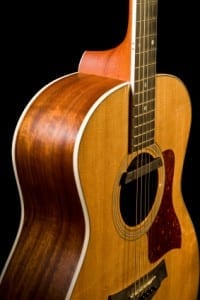Acoustic Guitar Pickups (Piezo, Sound Hole and Humbuckers)
Electric guitar pickups are usually presented front and center, so you always have an idea of what kind of sound you’ll be getting. And even though most guitarists are familiar with the two different kinds of electric pickups (single-coil and humbuckers), there are tons of variations on each type, which we’ve explored in a couple of different articles.
Acoustic guitar pickups, however, are a completely different beast, as most use a piezo pickup. While both primary electric guitar pickups are magnetic, meaning they amplify the sound by creating a magnetic circuit between the pickup and the metal strings, piezo pickups are based on the vibration of the strings.
This makes sense, of course, as the sound of the acoustic is dependent upon those vibrations in relation to the body of the instrument -- and it’s the pickup’s job to recreate that. So instead of using magnets, the piezo pickup is typically made of polymers that create an electric charge that works in relation to the amount of pressure applied to them through string vibration.
Piezo Bridge Pickups

If you are looking at an acoustic-electric model guitar that comes from the factory, you likely won’t see any indication of a pickup. This is because the piezo pickup is hidden under the saddle of the bridge where they can pick up maximum vibration.
Typically all the wiring will be hidden inside the guitar for an instrument with a bridge pickup, with the 1/4” input also serving as a strap holder on the end of the guitar. This, of course, can vary depending on guitar brand and model.
As you can probably imagine, piezo pickups are not just used for acoustic guitars, but also for any stringed acoustic instruments, including upright basses, violins and cellos.
Sound Hole Pickups
You’ve probably also seen pickups inserted into the sound hole of acoustic guitars - these are often used in live and studio performances for guitars that did not come equipped with a bridge pickup. However, some acoustic players prefer these to the bridge pickup models.
Since these pickups are not in direct contact with the strings, they must be magnetic pickups, and come in both single-coil and humbucker models. Many companies manufacture both kinds, and just like with electric guitars, it’s really up to player preference as to which sounds better.
Sometimes you’ll see these types of pickups coupled with (and sometimes even made with) a sound hole cover. These covers help reduce the risk of feedback by magnetic pickups mentioned above. However, piezo pickups also can cause feedback because of how acoustic guitars are made, so sound hole covers often can come in handy with those pickups, as well.
Recording with Acoustic Guitar Pickups
Most of the time acoustic pickups are relegated to live use, as none can reproduce the natural sound of an acoustic guitar as well as using a great microphone on the instrument. However, as we mentioned in our article on how to record acoustic guitars , recording a direct input acoustic can be a great way to achieve a different acoustic sound, and may be just what your particular recording needs.




